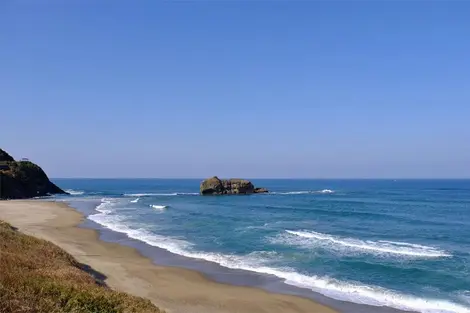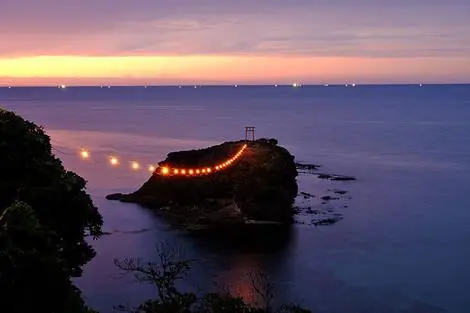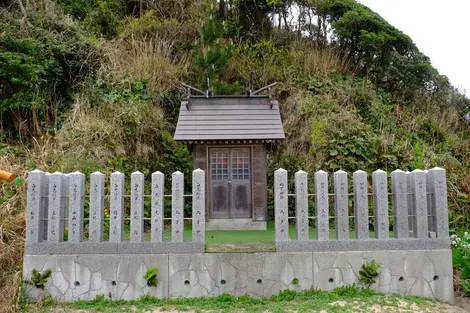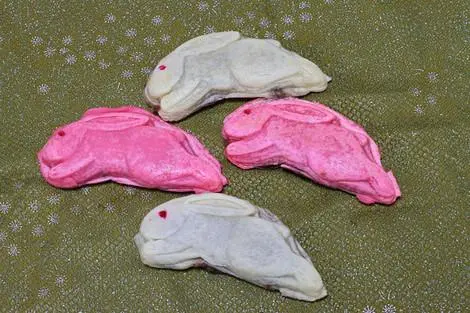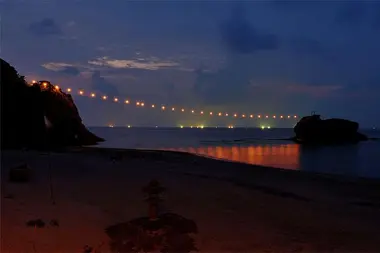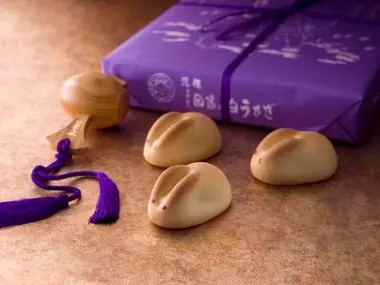Hakuto Beach 白兎海水浴場
- Published on : 25/01/2018
- by : S.V.
- Youtube
The coast of the white rabbit
Pleasant for swimming, ideal for surfing, the beautiful white sand beach of Hakuto in Tottori prefecture is at the heart of several Japanese founding myths. Hakuto beach has the ability to seduce both fans of idleness wishing to lie on the sand with their toes fanned out, but also fans of Japanese culture, history and mythology buffs.
The Legend of the White Rabbit of Inaba
The coast home to Hakuto Beach is nicknamed the White Rabbit Coast . But what the hell would a rabbit do on a white sand beach? He is quite simply the hero of one of the most famous legends of the country! Told in the Kojiki, an 8th century collection retracing the origin of the kami (gods of Shintoism ) and the formation of the archipelago , the legend of the white rabbit of Inaba, Inaba noShirousagi, is that of a rabbit carried away by a flood on the island of Oki. Prisoner of the rocky islet, the rabbit wishes to return to the continent and to do this sets up a clever stratagem. He agrees with the sharks (or crocodiles in some versions) to count them all by jumping on their backs if they get side by side between the small island and the beach. This would end a quarrel: who are the more numerous between rabbits and sharks? The sharks comply and the rabbit begins his return to the mainland. But near the beach, the rabbit cannot contain his joy and congratulates himself on his clever cunning. Furious, a shark manages to skin him before he reaches the shore. Suffering terribly, the rabbit meets the brothers of Ôkuninushi (a god of Shintoism) who advise him to bathe in sea water. This bad joke makes the pain unbearable. He eventually finds help from Ôkuninushi himself who suggests that he dive into the healing waters of Mitarashi-ike pond. As a thank you, the cured rabbit who is a kami , predicts to his savior that he will marry the coveted Princess Yagami.
See also: Books of Japanese legends
The temple of medicine
A few hundred meters from the beach, the Hakuto-jinja temple, founded in 1669, is dedicated to the rabbit kami . This temple is said to have the power to heal burns and skin diseases. It is perceived as the cradle of Japanese medicine but also of veterinary medicine. Its pond mentioned in the legend, the Mitarashi-ike, has the particularity of constantly having the same level; whatever the time of year. You can pray to several statues bearing the effigy of the white rabbit and come and place small white pebbles called musubi-ishi there to hope that your wish will come true. The myth of the white rabbit has given rise to many books, children's stories, poems and songs . These literary traces are scattered around: a stele engraved with a poem is located inside the Hakuto-jinja, another bearing the words of a song is placed on the seafront.
Closer to legend
150 meters west from the beach, you can see the small islet where the rabbit was trapped. This volcanic rock islet even looks like a rabbit , shown lying down with its hind legs extended! At low tide, reefs emerge from the water and look like the backs of sharks. This zoomorphic nature is truly disturbing! At the top of the island, nearly 10 meters high, sits a torii (traditional Shinto gate) marking the sacredness of the place and the entrance to the Shirousagikawashimo-jinja , built on the beach. "Shirousagikawashimo-jinja" literally means the downstream shrine of the Shirousagi legend, i.e. the shrine closest to the location of the legend and the islet. Every August 1 , a garland symbolizing divine lights connects the torii to the small sacred building. Religious ceremonies also take place on the beach.
Hakuto, land of love
In legend, the long-eared matchmaker who turned out to be a kami is the god of the marriage of two gods, Ôkuninushi and Princess Yagami. Their romance is the oldest love story in the archipelago. Hakuto therefore enjoys special appeal to lovers as the birthplace of Japan's first love story. Hakuto Beach was even designated " Sacred Land of Lovers " in 2010. Before leaving, do not hesitate to bite into the Inaba white rabbit in the form of manjū ( inaba no shirousagimanjû ) or taiyaki stuffed with anko (red bean paste). To be enjoyed as a couple in front of a sunset!
Address, timetable & access
Address
Phone
+81 (0)857-26-0756Timetable
From JR Tottori station, Hinomaru line bus direction Shikano, Hakuto Jinja-mae stop (40 minutes)Price
FreeAccess
Open every dayWebsite
http://www.tottori-guide.jp/tourism/tour/view/22








